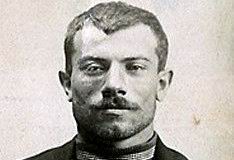Lucheni believed in propaganda by the
deed, a philosophy advocating spreading beliefs through
direct action.
Born in Paris to an Italian mother
and raised in an orphanage, he worked odd jobs before
joining the Italian Army for three and a half years.
After a successful stay in the military, he immigrated
to Switzerland. During his life in Switzerland, he
developed his anarchistic ideas. However, other
anarchists considered Lucheni inept at understanding the
philosophy of anarchy and often referred to him as "the
stupid one".
Lucheni sought to kill a member of
what he felt was an elite and oppressive upper class,
and he did not care which member of it he killed. In his
diary, Lucheni penned, "How I would like to kill someone
— but it must be someone important so it gets in the
papers."
At first Lucheni decided that he
would kill Philippe, Duke of Orleans, but due to the
Duke's change of itinerary and the discovery of another
royal being in town, he later settled for taking the
life of Elisabeth. Elisabeth traveled with few
bodyguards, as she was adored by the populace in
general.
It is generally held that while she
was boarding a steamship to Montreux on September 10,
1898 in Geneva, Lucheni stabbed her with a needle file (which
is now part of the Vienna Sisi Museum's exhibition). Not
realising she was hurt and wanting to board as quickly
as possible, Elisabeth got to her feet straight way and
walked onto the ship, where she later collapsed and died.
At his trial, Lucheni openly admitted
to his crimes, and at the age of 25, was sentenced to
life in prison. After his memoirs were confiscated by
prison guards, he was found hanged in his cell by his
belt on October 19, 1910, apparently a suicide.
Lucheni's assassination of Elisabeth
gave rise to the International Conference of Rome for
the Social Defense Against Anarchists held from November
24 to December 21, 1898. This conference agreed on a
definition of anarchism as "any act that used violent
means to destroy the organization of society".
References

